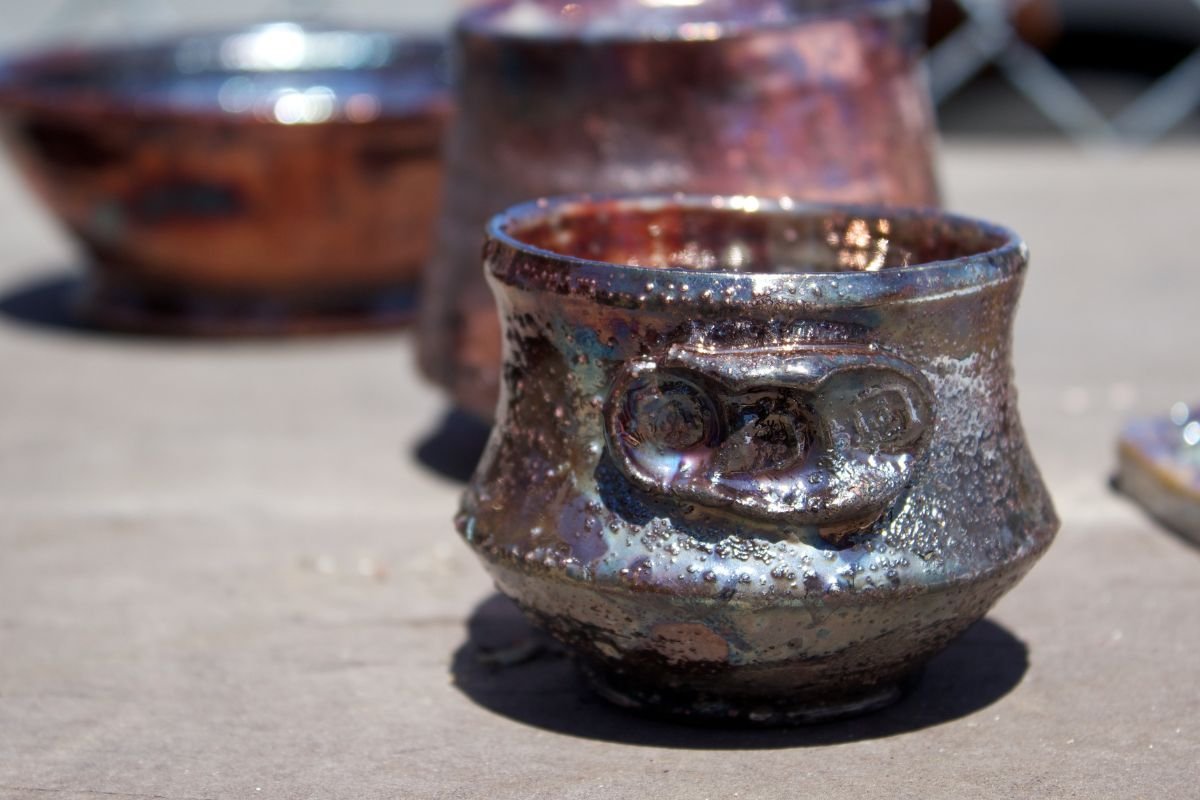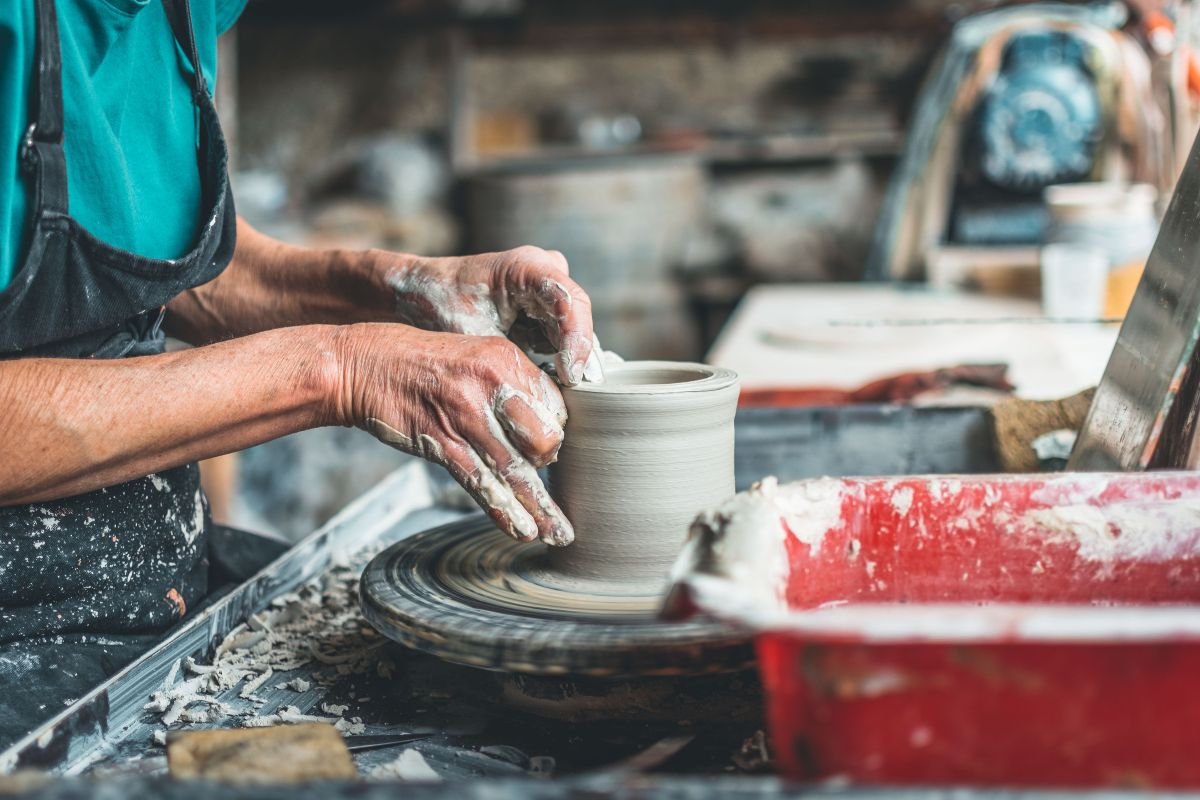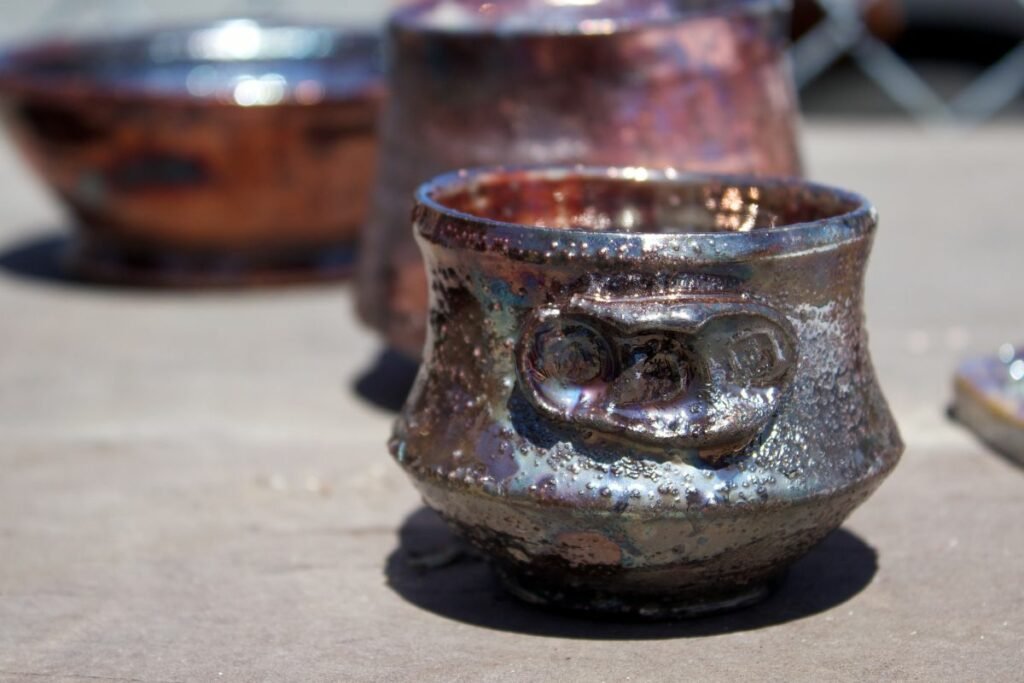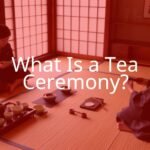Raku is a broad term for a low-fire technique that was modeled after classic Japanese raku firing. Western-style raku typically entails taking ceramics out of the kiln while it’s still hot and putting them in containers with flammable ingredients.
The canisters are shut once the ingredients catch fire. This creates a strong reduction atmosphere that has an impact on the colors of clay bodies and glazes.

The severe heat shock also causes cracking, which is sometimes called crackling since it is intentional. The original Japanese raku style developed as a result of Buddhist influences on daily life, particularly in the tea ritual.
Traditionally, raku pottery was created by heating the clay in an exposed kiln. It is now made in numerous nations, including America, thanks to its rising popularity worldwide.
Raku pottery is made in kilns that heat up significantly more quickly than regular kiln firings. The potter takes the pottery out of the kiln while it is glowing orange and puts it in a container filled with combustibles like sawdust.
The surface of said pottery is left with distinctive colors and textures as a result of this procedure. This article will discuss raku pottery; including its origins and how it is used today.
The History Of Raku Pottery
Research reveals that raku was created expressly for Zen Buddhist Masters for their ceremonial teaware in the early 1550s.
In the sixteenth century, Raku pottery was created by the Japanese. A Zen tea master named Sen Rikyu gave Chjir, a potter from the Japanese city of Kyoto, a commission.
The Raku technique has a single goal; to encourage beauty. Instead of using a wheel, potters choose to hand-form Raku ceramics. Each Raku piece communicates uniqueness and beauty in this way.
Have you ever witnessed a Japanese tea ceremony? They usually use Raku pottery. The lovely simplicity and unpretentiousness of this art form were praised by the tea master.
Due to their aesthetic appeal, Raku wares have been among the most sought-after Japanese ceramics from 1580 to 2020. Raku pottery is frequently regarded as the epitome of Zen.
Raku pottery touches on many of the characteristics that Zen philosophy possesses, most prominently its simplicity and naturalness, and it has long been known that this was the preferred form of ceramics for Zen Buddhist masters.
Among the most organic fire methods you might come across in ceramics is raku. All four elements of nature—earth, fire, air, and water—are incorporated in raku firing.
The pot is made from earth and then placed in a reduction kiln before being submerged in water.
The firing process is halted by the cold water. Raku literally translates as “happiness in the accident,” which is a nice detail about the practice.
What Is The Difference Between Western And Traditional Japanese Raku?
The Western Raku method is distinct from traditional Japanese Raku. Western Raku uses vibrant metallics, while Japanese Raku frequently uses muted shades like black and brown.
Aka (red) and Kuro (black) are the two primary varieties of raku used in Japan. Aka is colder than Kuro when they fire up the kiln. Differences in glazing maturation play a part.
A low melting coating seals the carbon deposits.
Western raku often has an avant-garde appearance. Raku’s success in the West is credited to American ceramic artist Paul Soldner.
Traditional Japanese Raku, which is commonly linked with tea ceremonies, which are spiritual practices of Zen that can last for up to four hours.
Various Clays In Raku Pottery

Any kind of clay may be used in a raku firing, however the greatest results are obtained when using specialized raku clay, which can be purchased.
High thermal shock resilience and little shrinkage are typical properties of raku clay. Selecting the perfect glaze, one whose characteristics respond to a raku fire in the best way, is another crucial step in the construction of your raku firing.
Top Glazes
Most significantly, since raku is a low-fire kiln procedure, practically any low-fire glaze should function just fine, whether you purchased it from a store or made it yourself. Raku firings typically achieve temperatures in the cone 010–06 range.
There are various ways to embellish raku, and not all of them call for glazing. Due to its toxicity, glaze in Raku is rarely used by Western potters.
Other metals that have different effects can be used in Raku as glazes. Raku and glaze have a problem since it employs a low firing temperature. Low temperatures make it such that the glaze doesn’t adhere to clay as well.
Food Safety In Raku Pottery
Despite the fact that raku has a long history and was once employed in ceremonial tea rituals, it is advised to keep the items strictly decorative.
This is partly because it is burned quickly; as a result, despite being beautiful, it can also be porous, delicate, and occasionally the glaze may flake in some spots. The items are not intended to be utilized as functional goods, despite the fact that they may look amazing.
Kilns
A variety of raku kilns are available and are designed especially for raku firing methods. However, skilled potters can also construct homemade raku kilns out of dustbins.
The item is typically bisque fired first, followed by a raku firing.
The glaze is then applied, and raku burning is performed. If you’re throwing any raku ware into a fire, a firing can happen in as short as 15 to 20 minutes.
The raku firing cycle is typically significantly faster than a regular firing. Your ceramic items must be placed in combustible material, such as sawdust, for raku firing.
Be prepared because raku firing produces a lot of smoke.
Final Thoughts
Hopefully, this article has helped to explain Raku pottery. There are two varieties; Western Raku and Traditional Japanese Raku.
By separating itself from Japan’s binding traditions, Western Raku was able to recreate itself.
Traditional Japanese Raku incorporates many deep abstract ideas and qualities inside it, such as harmony and compassion, for people who desire a more spiritual experience.
Perhaps you should read up on the tea ceremony.
To see how Raku pottery turns out, try making some for yourself. You must be aware of the differences between Western and traditional Japanese methods in order to comprehend raku.
- What Is a Maiko? - July 13, 2025
- What Does Domo Arigato Mean? - July 12, 2025
- What Does Naruto Mean? - July 12, 2025









